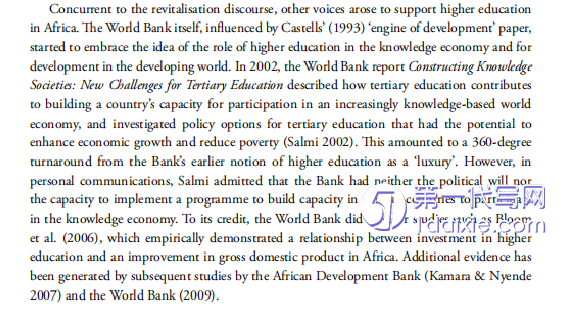本文是一篇英语论文,笔者认为结构转换中主要包括肯定和否定句式转换、语态转换和句子成分位置转换;类别转换主要涉及词性转换其中包括英文形容词转换为中文动词以及英文介词转换为中文动词;单位转换主要包括英文单词转换为中文短语或英文短语转换成中文句子实现句意完整。
Chapter 1 Task Description
1.1 Task Background
China has issued a series of documents about higher education, such as The Implementation for the Audit and Evaluation of Undergraduate Education and Teaching in Universities, Reform Plan for Adjustment and Optimization of Disciplines and Specialties in General Higher Education, Several Opinions on Further Promoting the Construction of World-Class Universities and Disciplines (Jiang, 2019). This action shows that the Chinese government places importance on higher education and the construction of world-class universities. Since higher education is an urgent need for national political and economic development, the establishment of research universities accelerates the pace of world-class universities and world-class disciplines. Research universities significantly contribute to a country’s development. Analyzing the functions of higher education and the development of research universities in other countries is conducive to the exchange and cooperation between Chinese and other countries in higher education. China and Africa have been maintaining exchanges and cooperation in higher education all the time.
With the help of the Internet and related books, the writer has searched and analyzed studies on African higher education at home and abroad. Most of research works on African higher education are written by Chinese and African scholars. But there are few translations from both sides. Therefore, the translation practice not only provides a translation of an African work, but also shows the research findings of African scholars on higher education, which will help the communication and exchange of higher education ideas and practice researches between China and Africa.

1.2 Introduction to Authors
Knowledge Production and Contradictory Functions in African Higher Education is a publication for Higher Education Research and Advocacy Network in Africa (HERANA) project. The HERANA project, which analyzes the relationship between higher education and national development by studying the operation, structure, and dynamics of universities, has published more than 100 articles, reports, and manuals to share the knowledge gained from the project.
Knowledge Production and Contradictory Functions in African Higher Education is published by a non-profit academic book publisher in Africa — African Minds, which focuses on social sciences. The book, written by African scholars and scholars studying in Africa like Nico Cloete, Peter Maassen and Tracy Bailey, is a comprehensive exploration of the continent’s higher education.
The first author, professor Nico Cloete, is the former director of the Centre for Higher Education Trust and the coordinator of the Higher Education Research and Advocacy Network in Africa. He served as the general secretary of the Union of South African Democratic Staff Associations and published the book Knowledge Production and Contradictory Functions in African Higher Education in 2015.
Chapter 2 Theoretical Framework
2.1 Development of Translation Shifts Theory
Scholars began to study Translation Shifts Theory in the 1950s to reflect the relationship between the source text and target text in semantics, style and so on. The development of this theory can be classified into three stages including: the sprouting stage (the 1950s), the evolving stage (1960-1979) and the maturing stage (after 1980) (Li, 2005).
In the sprouting stage, the impact of linguistic research development is manifold, including the fact that linguistics has largely enriched the translation study. In 1958, two scholars, namely Vinay and Darbelnet, proposed two practical translation strategies, containing direct translation and indirect translation. Although they did not introduce the concept of translation shifts at that time, what they described conformed to Catford’s Translation Shifts Theory. They pointed out that direct translation included loanwords, imitation words and direct translation. Indirect translation contained lexical shifts, moderation, equivalence and adaptation (Vinay & Darbelnet, 1995).
In the evolving stage, John Cunnison Catford, an English linguist and translation theorist, put forward the Translation Shifts Theory in 1965. In A Linguistic Theory of Translation, Catford defined translation as the replacement of text in one equivalent language (the translation language) with text in another language (the source language) and stated that reciprocity was the key word in this replacement process (Catford, 1965). He classified the theory into two parts, including: level shifts and category shifts. The category shifts were composed of structure shifts, class shifts, unit shifts, and intra-system shifts. In Catford’s theory, he first defined the difference between “translation” and “transference”.
2.2 Content of Translation Shifts Theory
In A Linguistic Theory of Translation, Catford divides Translation Shifts Theory into two parts, containing level shifts and category shifts. And category shifts include structure shifts, class shifts, unit shifts and intra-system shifts.
Level shifts mean that the source language unit at one linguistic level has an equivalent in target language at a different linguistic level (Catford, 1965). There are four language levels: grammar, lexis, phonology and graphology. It is impossible to translate between phonology and graphology, or between any of the two and grammar and lexis. Translation equivalence relation requires that the source text and the target text are related to the same entity features. The entities of phonology and graphology are different. Therefore, the shift from grammar to lexis or lexis to grammar is the only level shift in the translation process.
The other part of Translation Shifts Theory is category shifts which include structure shifts, class shifts, unit shifts and intra-system shifts. There are few cases about intra-system shifts, hence intra-system shifts are not analyzed in the paper. Category shifts refer to the detachment of formal correspondence in the translation process. At first, unit is a category to describe linguistic activities that contain recurring and meaningful patterns that need to be explained. We call this structure, which is an arrangement of elements. And structure shift is the most common shift in translation at all levels, occurring in phonology translation, graphology translation and complete translation. And structure shifts in grammar can occur in all ranks, such as phrases and sentences (Catford, 1965).
Chapter 3 Translation Process ............................ 9
3.1 Pre-translation Preparations ........................................ 9
3.1.1 Parallel text reading ..................................... 9
3.1.2 Translation tools .................................... 10
Chapter 4 Case Analysis .............................. 13
4.1 Level Shifts ...................................... 13
4.2 Category Shifts ................................ 16
Chapter 5 Conclusion .................................... 35
5.1 Major Findings ................................ 35
5.2 Limitations ........................................... 36
Chapter 4 Case Analysis
4.1 Level Shifts
Language is a patterned system that consists of various categories in ladder structures, and each category at the lower level will play a certain language function in the category at the higher level (Halverson, 2007). According to Catford, there are significant disparities between “formal correspondence” and “text equivalence” among various languages (Catford, 1965). In order to eliminate this discrepancy, translation shifts must be used in the translation process, and the translator suggests that level shifts and category shifts in the Translation Shifts Theory are most clearly expressed.
Level shifts mean that a source language item at one linguistic level has a target language translation equivalent at a different level (Catford, 1965). That means something expressed in grammar in the source language can be transformed into words and phrases in the target language. And something can be transformed from words or phrases in the source language into grammatical forms in the target language. In a word, level shifts mainly include lexis shifts and grammar shifts.
Chinese belongs to the Sino-Tibetan language family. The shapes of Chinese words do not change according to word cases, parts of speech, plurals, tenses, etc. Chinese frequently uses separate function words and fixed word order to indicate the grammatical meaning. English is an inflected language that is a member of the Indo-European family and in which inflections serve to indicate grammatical relations (Li & Hu, 2020). English varies in forms, which can be used to express different tenses, quantities, and degrees by changing the shapes of words. In English, there are countable and uncountable nouns. Countable nouns are in both singular and plural forms.

Chapter 5 Conclusion
5.1 Major Findings
The translator offers a thorough analysis of Catford’s Translation Shifts Theory, emphasizing its classification and impact on the translation process depending on linguistic characteristics of the source text. She applies Catford’s Translation Shifts Theory to academic text translation from the perspective of level shifts and category shifts.
Translation shifts have been used in the translation process. Not only do they serve as a translation theory to direct translation practice, but they also act as translation skills. The translator examines passive, long, and complex sentences in English-Chinese translations with the use of structure shifts, turning some of them into active ones as a result of different expression habits. Long and complex sentences often contain multiple modifiers in English, which must be adjusted to ensure target readers can understand the translation. This translation process also involves structure shifts. Parts of speech should be transformed under the direction of class shifts due to the differences between Chinese and English. Phrases frequently need to be changed into clauses or sentences in order to maintain the flow and readability of the translation. And this transformation process is carried out under the guidance of unit shifts. In a word, the translator has covered a variety of shifts in translation practice under the guidance of Catford’s Translation Shifts Theory, which helps to demonstrate the value and significance of the theory.
reference(omitted)
